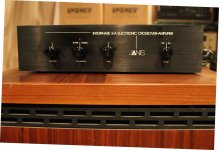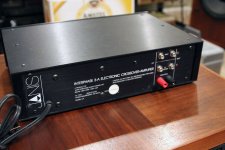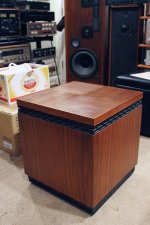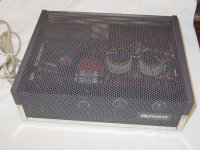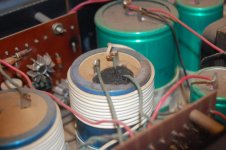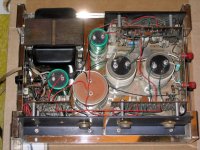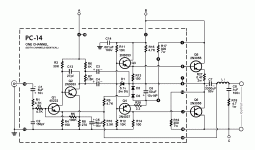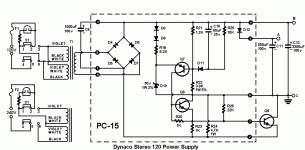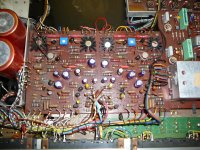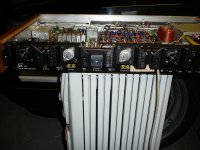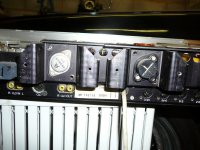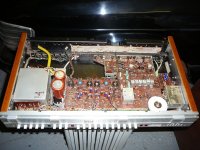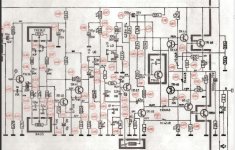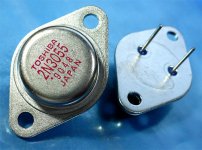Indeed, quite how it didn't blow up when subjected to a real speaker load is beyond me 😀 After all the supplys were +/- 55V... With 60V transistors including the MJ2955 i think enough has been said 🙂Maplin did a 225WRMS kit using these transistors.
I built mine around 1980.
Currently offers there unfortunately only this:
Audio Modules : Maplin Electronics
but BK could have such modules
Modules
"The OMP/MF range utilizes the latest Mos-Fet output devices"
Mean you this amp?The original Janis W1 subwoofer crossover/amp used the 3055 also. Regards David
Attachments
Hi - 'hope this helps. I recall servicing a Revox model 40 which was quasi/2N3055. Really classy internal construction and typical Studer quality components. It was a domestic 40 watt model dressed in the usual 70's timber sleeve. Worth collecting but not to listen to in my view anyway. Sorry, no info.
Thanks for this advice. But you mean certainly an other model, because model 40 is a tube integrated amp:Hi - 'hope this helps. I recall servicing a Revox model 40 which was quasi/2N3055. Really classy internal construction and typical Studer quality components. It was a domestic 40 watt model dressed in the usual 70's timber sleeve. Worth collecting but not to listen to in my view anyway. Sorry, no info.
REVOX Modell 40 Stereo-Rhrenverstrker
but by chance I have found in this hifi music center the 2N3055, that I have get for service three weeks ago (only german but nice pics):
hifimuseum.de - Sie sind im Bereich : WEGA Studio 3208
Thanks for this advice. But you mean certainly an other model, because model 40 is a tube integrated amp:
REVOX Modell 40 Stereo-Rhrenverstrker
Of course, you are correct. I can't recall why that ref. is in my notes from around 10 years ago. Having checked out net images, the closest I can see is model A50 but this is 80W and is about 30mm taller, otherwise very similar in fascia, even the 4 T03s on rear. Anyway, you are after US & UK types. I wish you luck there.
Ultimate sounded Dynaco ST120 (ST-120) from 1966
Dynaco Stereo 120 - this is now the oldest commercial amp employed 2N3055 in the output stage that I have found - already mentioned about #9.
Dynaco_120
http://www.diyaudio.com/forums/solid-state/156627-dynaco-stereo-120-can-beautiful-2.html
http://www.diyaudio.com/forums/solid-state/120258-dynaco-st-120-i-got-little-screwed.html
Review - Summary - Quote:
Let me start by saying, right out of the box, this amp sounds amazing. After about 60 hours or so, it became even better. I had Bob Latino build the ST120 for me with all of the upgrades including the upgraded chassis.
There are 2 things that just plain stand out about this amp. The first is the outstanding bass response, its very tight, strong and digs very deep. There is no hint of sloppiness. The second, is the incredible head room, this amp has the most I have ever seen in a tube amp.
I did a side-by side with the ST120 and my dad's fully restored MC240. The ST120 easily did everything the 240 did but much, much better. Where the 240, at time, had a flabby and somewhat sloppy bass the ST120 was strong and tight. Even with the ST120 in triode mode(about 32wpc) the ST120 still had a lot more power and head room then the MC240 did.
The sound from the ST120 is very open with an excellent sound stage and some of the best imaging I have ever herd. It as if I could reach out and touch the band members. In the past, with other amps that I use in rotation, I have always used a power sub to fill in what seemed to always be missing. With the ST120, there is no need for me to use a sub as this amp digs very deep. The midrange is to die for with natural, clear high end. The amp runs quiet and is SUPER clean.
On paper, SS amps have better damping factors, THD, and S/N then most tube amps. Well the ST120 will give them all a run.
I can tell you that there are NO NEW tube amps that will come anywhere near the performance of the ST120 and it will hang with and out do amps at up to 3 times the cost.
If you are looking for a tube amp with the sound quality, build quality and BALLS, well this is it. This amp just plain gets it done and dose it very well.
And the best part, is Bob's costumer service. It is second to none. He is always there to help via phone and email. He stands behind his products and backs them with a very good warranty.
This is a very hi-end amp at an average person's price.
Also CM-labs (CM 911, CM911) looks interesting, but there are no schematics to find and it is newer than the Dynaco 120.
But which model with 2N3055 was the first ? - and a pic of RCA's first advertisement I want to see
Dynaco Stereo 120 - this is now the oldest commercial amp employed 2N3055 in the output stage that I have found - already mentioned about #9.
Dynaco_120
http://www.diyaudio.com/forums/solid-state/156627-dynaco-stereo-120-can-beautiful-2.html
http://www.diyaudio.com/forums/solid-state/120258-dynaco-st-120-i-got-little-screwed.html
Review - Summary - Quote:
Let me start by saying, right out of the box, this amp sounds amazing. After about 60 hours or so, it became even better. I had Bob Latino build the ST120 for me with all of the upgrades including the upgraded chassis.
There are 2 things that just plain stand out about this amp. The first is the outstanding bass response, its very tight, strong and digs very deep. There is no hint of sloppiness. The second, is the incredible head room, this amp has the most I have ever seen in a tube amp.
I did a side-by side with the ST120 and my dad's fully restored MC240. The ST120 easily did everything the 240 did but much, much better. Where the 240, at time, had a flabby and somewhat sloppy bass the ST120 was strong and tight. Even with the ST120 in triode mode(about 32wpc) the ST120 still had a lot more power and head room then the MC240 did.
The sound from the ST120 is very open with an excellent sound stage and some of the best imaging I have ever herd. It as if I could reach out and touch the band members. In the past, with other amps that I use in rotation, I have always used a power sub to fill in what seemed to always be missing. With the ST120, there is no need for me to use a sub as this amp digs very deep. The midrange is to die for with natural, clear high end. The amp runs quiet and is SUPER clean.
On paper, SS amps have better damping factors, THD, and S/N then most tube amps. Well the ST120 will give them all a run.
I can tell you that there are NO NEW tube amps that will come anywhere near the performance of the ST120 and it will hang with and out do amps at up to 3 times the cost.
If you are looking for a tube amp with the sound quality, build quality and BALLS, well this is it. This amp just plain gets it done and dose it very well.
And the best part, is Bob's costumer service. It is second to none. He is always there to help via phone and email. He stands behind his products and backs them with a very good warranty.
This is a very hi-end amp at an average person's price.
Also CM-labs (CM 911, CM911) looks interesting, but there are no schematics to find and it is newer than the Dynaco 120.
But which model with 2N3055 was the first ? - and a pic of RCA's first advertisement I want to see
Attachments
Last edited:
I have worked on the Revox 40 watt model this was a well built transistor amplifier fitted with 2N3055 output devices
What was unusual about this amplifier is that the 1 ohm emmitter resistors were by passed with 1N4004 power diodes as per the 2nd version of the Edwin amplifier as feature in another post on the forum
I swept the amplifier and noticed a sharp change in Gm as the pwer diodes were switched on
As I remember it was an ok amplifier for the time but built like a tank
regards Trevor
What was unusual about this amplifier is that the 1 ohm emmitter resistors were by passed with 1N4004 power diodes as per the 2nd version of the Edwin amplifier as feature in another post on the forum
I swept the amplifier and noticed a sharp change in Gm as the pwer diodes were switched on
As I remember it was an ok amplifier for the time but built like a tank
regards Trevor
Here is a few pics of my B&O Beocenter 3500, which uses the same chassis as the previously mentioned Beomaster 3000.
Quoted power output is 40w/channel, Single 60V rail, AC coupled output.
Beomaster 3000 was introduced around 1969.
Currently waiting for a new pair of output capacitors to finish the electrical restoration of this unit.
Quoted power output is 40w/channel, Single 60V rail, AC coupled output.
Beomaster 3000 was introduced around 1969.
Currently waiting for a new pair of output capacitors to finish the electrical restoration of this unit.
Attachments
Last edited:
Hi Tiefbass, guys
You are close there with the Dynaco. Heath had something to do with that or a similar design which was also released as a kit. David Hafler, of course, was involved there somwhere with Dynaco and Dynakit.(OT: remember the later Hafler-Dynaco surround sound system?) I recall advertisements to that effect in Radio Electronics magazine. I think our American hosts will have something more precise to say than my recollections. It sure takes a while to gather a bit of info.
You are right Iatala, the Revox was built like a tank and the crossover glitch had me diving for the power switch. Do you recall the model No.?
Just a bit of trivia: When Silicon Valley started to "clone" the 2N3055, Fairchild released kits of output transistors for manufacturers and later for hobbyist use in this country. The kits were a sealed clear plastic bag containing 2 x 2N3055+ 2 x (I think) T05 drivers) They were steel cased, like later issues but marked in red with house codes.
At the same time, a kit containing a pair of TO66s and possibly several smaller T05s,TO18s was available. That may have been from Texas. The kits were very cheap compared to 1 off prices which were probably for RCA originals. Even here, hobbyists had access to these in 1970 but I believe the first local kit of a 2N3055 amp. was in 1968. I built my first kit, a full kit integrated stereo amplifier with AM tuner using marked Fairchild 2N3055s in 1970. It was an awful adapted Mullard circuit IMO which delivered 2 x 45W from a single, regulated rail but still works with original parts! I would not, however, enter it in a "high end" audio competition.
Surely such offers would have been made even earlier in Europe and the UK where competition and demand would have been much greater and important to the establishment of the "Epitaxial" as market leader. Perhaps, we hobbyists just bought dumped kit overruns.
Waki, did you manage to get up to the attic and dig out the Rogers amp? It would be good to know what else was 'under the bonnet' and manufacture date, if that was marked.
regards
You are close there with the Dynaco. Heath had something to do with that or a similar design which was also released as a kit. David Hafler, of course, was involved there somwhere with Dynaco and Dynakit.(OT: remember the later Hafler-Dynaco surround sound system?) I recall advertisements to that effect in Radio Electronics magazine. I think our American hosts will have something more precise to say than my recollections. It sure takes a while to gather a bit of info.
You are right Iatala, the Revox was built like a tank and the crossover glitch had me diving for the power switch. Do you recall the model No.?
Just a bit of trivia: When Silicon Valley started to "clone" the 2N3055, Fairchild released kits of output transistors for manufacturers and later for hobbyist use in this country. The kits were a sealed clear plastic bag containing 2 x 2N3055+ 2 x (I think) T05 drivers) They were steel cased, like later issues but marked in red with house codes.
At the same time, a kit containing a pair of TO66s and possibly several smaller T05s,TO18s was available. That may have been from Texas. The kits were very cheap compared to 1 off prices which were probably for RCA originals. Even here, hobbyists had access to these in 1970 but I believe the first local kit of a 2N3055 amp. was in 1968. I built my first kit, a full kit integrated stereo amplifier with AM tuner using marked Fairchild 2N3055s in 1970. It was an awful adapted Mullard circuit IMO which delivered 2 x 45W from a single, regulated rail but still works with original parts! I would not, however, enter it in a "high end" audio competition.
Surely such offers would have been made even earlier in Europe and the UK where competition and demand would have been much greater and important to the establishment of the "Epitaxial" as market leader. Perhaps, we hobbyists just bought dumped kit overruns.
Waki, did you manage to get up to the attic and dig out the Rogers amp? It would be good to know what else was 'under the bonnet' and manufacture date, if that was marked.
regards
Oh yes
I forgot the first Rogers Transistor amplifier used 2n3055 in an unusual transformer driver circuit loved that amplifier I have a no of them in my collection
Their was also the Leak stereo 30+ this also used the venerable 2n3055
Sorry I have no idea of the Revox model no
regards Trev
I forgot the first Rogers Transistor amplifier used 2n3055 in an unusual transformer driver circuit loved that amplifier I have a no of them in my collection
Their was also the Leak stereo 30+ this also used the venerable 2n3055
Sorry I have no idea of the Revox model no
regards Trev
Also CM-labs (CM 911, CM911) looks interesting, but there are no schematics to find and it is newer than the Dynaco 120.
I've collected a couple of schematics for the CM 911... one is dated 1966. The output transistors are only identified by house numbers, and none of the pictures I've found of CM 911 amps show the transistors clearly enough to read the part numbers. There are notes on one of the schematics with substitutes for the CM house numbers; CM10 (the output devices) is 2N3773 or 2N5631.
(2N3773 and 2N5631 come up as 16A 140V NPN)
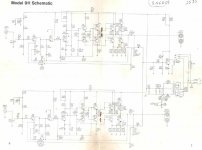
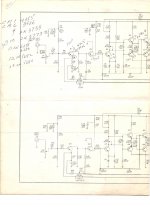
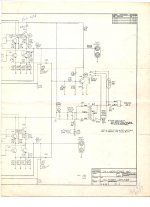
Last edited:
I've collected a couple of schematics for the CM 911... one is dated 1966. The output transistors are only identified by house numbers, and none of the pictures I've found of CM 911 amps show the transistors clearly enough to read the part numbers. There are notes on one of the schematics with substitutes for the CM house numbers; CM10 (the output devices) is 2N3773 or 2N5631.
(2N3773 and 2N5631 come up as 16A 140V NPN)
View attachment 168926 View attachment 168927View attachment 168928
Thank you very much, interesting topology
here more devices: Leak Stereo 30(plus), Vox, Rogers A100, Revox A78
Vox Supreme
Consumer Audio Information
THE HOME PAGE FOR COLTRONICS-ROGERS Hi-Fi SPECIALIST
Attachments
-
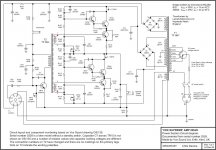 VOX Supreme Power Section Schem .jpg112.9 KB · Views: 2,150
VOX Supreme Power Section Schem .jpg112.9 KB · Views: 2,150 -
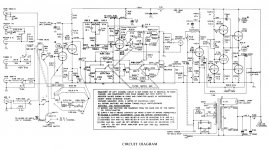 Leak cctStereo30.jpg206.3 KB · Views: 2,137
Leak cctStereo30.jpg206.3 KB · Views: 2,137 -
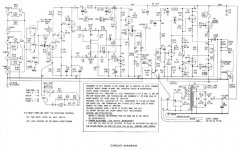 Leak Stereo30Plus.jpg128.2 KB · Views: 2,079
Leak Stereo30Plus.jpg128.2 KB · Views: 2,079 -
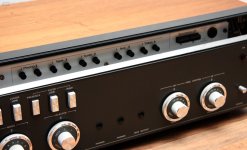 revox-A78.02.jpg133.4 KB · Views: 439
revox-A78.02.jpg133.4 KB · Views: 439 -
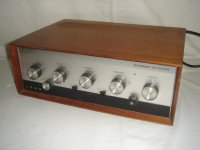 Leak Stereo 30 plus.jpg38.2 KB · Views: 1,938
Leak Stereo 30 plus.jpg38.2 KB · Views: 1,938 -
 Leak Stereo70.jpg185.2 KB · Views: 2,027
Leak Stereo70.jpg185.2 KB · Views: 2,027 -
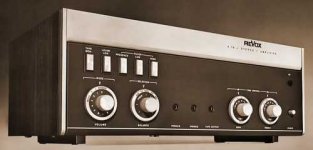 revox-a78.jpg12.1 KB · Views: 382
revox-a78.jpg12.1 KB · Views: 382 -
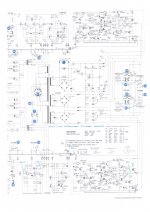 SM_A78_4.jpg458.3 KB · Views: 731
SM_A78_4.jpg458.3 KB · Views: 731 -
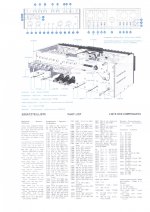 SM_A78_6.jpg489 KB · Views: 706
SM_A78_6.jpg489 KB · Views: 706 -
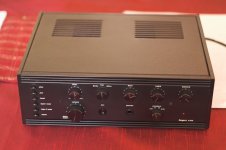 Rogers A100 front.jpg76.4 KB · Views: 561
Rogers A100 front.jpg76.4 KB · Views: 561
Last edited:
Rogers A100 inside photos:
Rogers A100 inside photos and A75/Panthera/Ravensbourne:
Rogers Panthera A75 | Owners Manual, Service Manual, Schematics, Free Download | HiFi Engine
ROGERS AMP on Flickr - Photo Sharing!
rogers repairs
Rogers Ravensbourne rebuild - UK Vintage Radio Repair and Restoration Discussion Forum
Rogers A100 inside photos and A75/Panthera/Ravensbourne:
Rogers Panthera A75 | Owners Manual, Service Manual, Schematics, Free Download | HiFi Engine
ROGERS AMP on Flickr - Photo Sharing!
rogers repairs
Rogers Ravensbourne rebuild - UK Vintage Radio Repair and Restoration Discussion Forum
Attachments
-
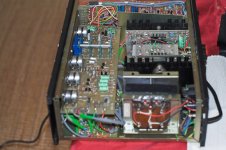 Rogers A100 inside III.jpg130.4 KB · Views: 514
Rogers A100 inside III.jpg130.4 KB · Views: 514 -
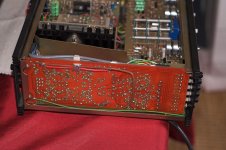 Rogers A100 inside-II.jpg129.9 KB · Views: 412
Rogers A100 inside-II.jpg129.9 KB · Views: 412 -
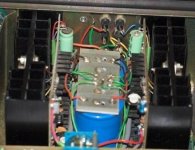 Rogers A100 inside.jpg38.1 KB · Views: 462
Rogers A100 inside.jpg38.1 KB · Views: 462 -
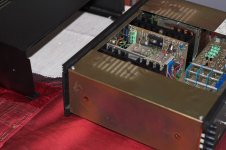 Rogers A100 inside IV.jpg112 KB · Views: 429
Rogers A100 inside IV.jpg112 KB · Views: 429 -
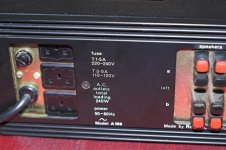 Rogers A100 rearI.jpg133.2 KB · Views: 334
Rogers A100 rearI.jpg133.2 KB · Views: 334 -
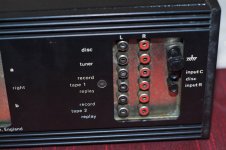 Rogers A100 rear-II.jpg118.7 KB · Views: 369
Rogers A100 rear-II.jpg118.7 KB · Views: 369 -
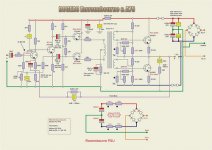 Rogers Ravensbourne schematic.jpg78.3 KB · Views: 971
Rogers Ravensbourne schematic.jpg78.3 KB · Views: 971 -
Rogers Ravensbourne.pdf117 KB · Views: 372
Hi tiefbass
I shouldn't really try and answer your query on this because I havent used them but technicians routinely replaced countless numbers of 2N3055s and larger in mainframe linear power supplies. Many went astray and miraculously reappeared in technicians audio systems in the 1970s. Techs. loved the Toshibas as I recall because most were were said to have Ft of 4Mhz rather than RCA 500kHz and Fairchild (I think) 1Mhz. Motorolas (aluminium) version I cannot recall. Tower's transistor substitution manual published over many years in the UK listed a range of .5 to 4Mhz Ft for various clones and this supports above statement. This spares market would have been a vast dumping ground for any out of (higher) spec or overstocked parts from many manufacturers. If a mainframe or broadcast tech from the seventies were able to comment you might have a better picture confirmation or not there. It's bound to vary round the globe.
BTW you can always test beta at usually 0.5 amp (on a small sink is best) , BV and even Ft with some gear like a scope and a couple of suitable power supplies. Having seenyour excellent gallery of pics of gear, you probably have most of what's needed already.
regards
Ian
I shouldn't really try and answer your query on this because I havent used them but technicians routinely replaced countless numbers of 2N3055s and larger in mainframe linear power supplies. Many went astray and miraculously reappeared in technicians audio systems in the 1970s. Techs. loved the Toshibas as I recall because most were were said to have Ft of 4Mhz rather than RCA 500kHz and Fairchild (I think) 1Mhz. Motorolas (aluminium) version I cannot recall. Tower's transistor substitution manual published over many years in the UK listed a range of .5 to 4Mhz Ft for various clones and this supports above statement. This spares market would have been a vast dumping ground for any out of (higher) spec or overstocked parts from many manufacturers. If a mainframe or broadcast tech from the seventies were able to comment you might have a better picture confirmation or not there. It's bound to vary round the globe.
BTW you can always test beta at usually 0.5 amp (on a small sink is best) , BV and even Ft with some gear like a scope and a couple of suitable power supplies. Having seenyour excellent gallery of pics of gear, you probably have most of what's needed already.
regards
Ian
Ian
Funny you should mention old main frames I used to know a lovely man Bill Ogden who had the contract with ICL computors of Kidsgrove Stoke on Trent to dispose of unwanted and scrapp computors and parts
I would work for him part time and he would let me have transistors etc
I used them as if they were 2N3055 allthough they were numbered MA13
thats how I learned electronics at minimal expense
Regards Trev
Funny you should mention old main frames I used to know a lovely man Bill Ogden who had the contract with ICL computors of Kidsgrove Stoke on Trent to dispose of unwanted and scrapp computors and parts
I would work for him part time and he would let me have transistors etc
I used them as if they were 2N3055 allthough they were numbered MA13
thats how I learned electronics at minimal expense
Regards Trev
2N3055 was already a successor of much more older silicon power devices, like the 2N389 from Texas Instruments - here the short form data found by
Texas Instruments Vintage Transistors :
2N389, NPN Silicium Power Transistor, 140x140mil Chip. Single Diffused Process.
Manufacturer : Texas Instruments Year : 0-16 = week16, 1960 Package, Case style : Carton box, TO-53 with clip leads Spec's : Vcbo=?V, Vceo=60V,Hfe=12-60, Ic=3A, P=85W, Icbo(max)=10mA, ft=1MHz, Cobo=?pF Photo's : Picture1, Picture2, Picture3, Picture4, (Donated by Ronald Werner from Norway). General Purpose Power Switch and Amplifier. Industrial and Military usage.
Raytheon had release the first such types - I think - go to
Raytheon Part Two (Transistor History)
Raytheon Part One (Transistor History)
Jedec-code
for more informations.
In which amp models are this predecessor types inside (models between 1957 and 1963 - I think) ??
Texas Instruments Vintage Transistors :
2N389, NPN Silicium Power Transistor, 140x140mil Chip. Single Diffused Process.
Manufacturer : Texas Instruments Year : 0-16 = week16, 1960 Package, Case style : Carton box, TO-53 with clip leads Spec's : Vcbo=?V, Vceo=60V,Hfe=12-60, Ic=3A, P=85W, Icbo(max)=10mA, ft=1MHz, Cobo=?pF Photo's : Picture1, Picture2, Picture3, Picture4, (Donated by Ronald Werner from Norway). General Purpose Power Switch and Amplifier. Industrial and Military usage.
Raytheon had release the first such types - I think - go to
Raytheon Part Two (Transistor History)
Raytheon Part One (Transistor History)
Jedec-code
for more informations.
In which amp models are this predecessor types inside (models between 1957 and 1963 - I think) ??
Attachments
-
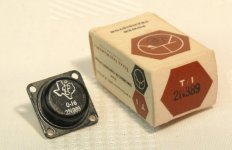 2N389-01A.JPG56.5 KB · Views: 406
2N389-01A.JPG56.5 KB · Views: 406 -
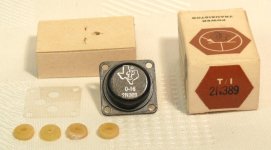 2N389-02A.JPG56 KB · Views: 314
2N389-02A.JPG56 KB · Views: 314 -
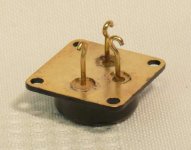 2N389-03A.JPG62.6 KB · Views: 335
2N389-03A.JPG62.6 KB · Views: 335 -
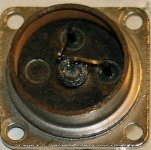 raytheon Si Power Cropped JK.jpg122 KB · Views: 410
raytheon Si Power Cropped JK.jpg122 KB · Views: 410 -
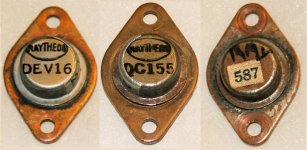 Raytheon Power silicon Rearranged V3.jpg68 KB · Views: 341
Raytheon Power silicon Rearranged V3.jpg68 KB · Views: 341 -
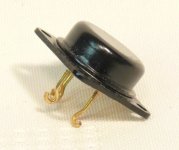 2N389-04A.JPG56.4 KB · Views: 284
2N389-04A.JPG56.4 KB · Views: 284 -
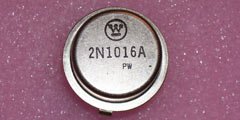 2N1016A.jpg8 KB · Views: 330
2N1016A.jpg8 KB · Views: 330 -
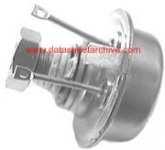 2N1016_1000001.jpg5 KB · Views: 257
2N1016_1000001.jpg5 KB · Views: 257
Last edited:
- Home
- Amplifiers
- Solid State
- 2N3055 inside - commercial famous amplifier models, quasi complementary power output
